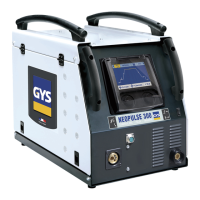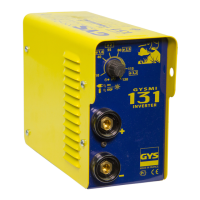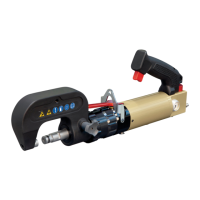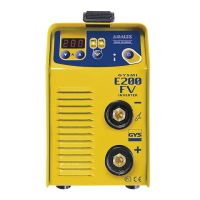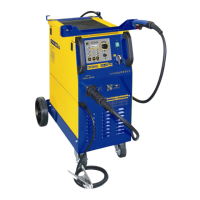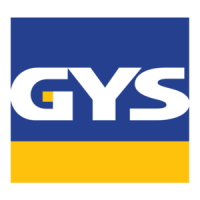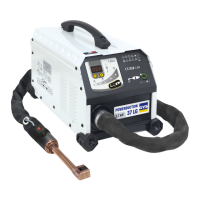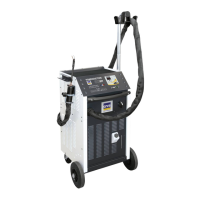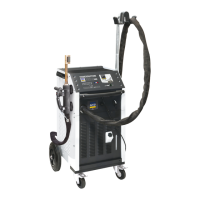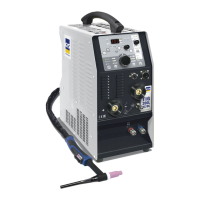Do you have a question about the GYS NEOFEED 4W and is the answer not in the manual?
Verify the availability of new software updates before initial device operation.
Calibrate the welding cables as per the procedure for optimal performance.
Understand and follow all safety instructions before operating the equipment.
Operate and store the equipment in suitable environmental conditions.
Wear appropriate protective gear for welding operations to prevent injury.
Ensure adequate ventilation and safety measures for welding fumes.
Identify and mitigate fire and explosion hazards associated with welding.
Handle and store gas cylinders safely to prevent accidents.
Follow guidelines to prevent electric shock during operation and maintenance.
Measures to minimize exposure to electromagnetic fields during welding.
Guidelines for safely transporting the wire feeder unit.
Proper installation procedures and environmental requirements for the feeder.
Important maintenance tasks and general recommendations for the equipment.
Overview of the main components and parts of the wire feeder.
Information on power supply voltage and connection cables for the generator.
Explanation of the wire feeder's control interface and its functions.
Guidance on connecting components and general advice before assembly.
Details on welding steel/stainless steel using MAG mode.
Procedures for welding aluminium using MIG mode.
Proper connection and adjustment of the gas supply for welding.
Overview of the interface structure and navigation menus.
Configuration parameters for MIG/MAG welding processes.
Manual settings and operation for GMAW/MIG-MAG welding.
Using the Dynamic STD mode for high-quality welding on various materials.
Utilizing pulse welding for improved heat control and appearance.
Specific pulse mode for vertical-up welding and enhanced control.
Using tack welding for pre-assembly and non-oxidized welds.
Features for spot welding timing and reproducibility.
Explanation of the standard 2-time trigger control welding cycle.
Explanation of the standard 4-time trigger control welding cycle.
Pulsed welding cycle using 2-time trigger control.
Pulsed welding cycle using 4-time trigger control.
Connecting and advice for Tungsten Electrode Welding with Inert Gas.
Guidelines for electrode preparation and selection for TIG welding.
Procedure for initiating the arc using the lift priming method.
Parameters and settings for TIG/GTAW welding processes.
Settings for standard DC TIG welding on various materials.
Parameters for DC TIG welding using pulse functionality.
Performing spot welds using DC TIG welding.
Executing tack welds with DC TIG for pre-assembly.
Utilizing E.TIG mode for constant power welding with arc length control.
Understanding trigger functions for 2-time and 4-time welding modes.
Connecting cables and advice for MMA/SMAW welding.
Guidance on selecting coated electrodes for MMA/SMAW welding.
Settings for coated electrode welding processes.
Using the standard MMA welding mode for various applications.
Applying pulse mode for MMA welding, especially in vertical positions.
Adjusting welding current based on electrode type and diameter.
Saving and loading welding configurations (Jobs).
Creating, saving, recalling, and deleting welding jobs.
Connecting and using digital remote controls for the wire feeder.
Accessing device information and general product settings.
Choosing the welding process (MIG-MAG, TIG, MMA).
Accessing and configuring welding parameters and display modes.
Accessing the calibration functions for speed and accessories.
Calibrating motorized reels and welding accessories.
Saving and loading welding configurations and jobs via USB.
Recording and analyzing welding operations for quality control.
Understanding project and bead information recorded during welding.
Setting and displaying energy parameters for welding.
Identifying and resolving common issues with the wire feeder.
Solutions for problems related to inconsistent wire feeding.
Addressing issues with welding current and arc stability.
Resolving issues with wire blockage and porous weld beads.
Troubleshooting splatter, gas flow, calibration, and download errors.
Handling errors related to data, USB, installation, and generator faults.
Safety warnings regarding moving parts of the wire feeder.
Information on the product's warranty coverage and exclusions.
Solutions for wire feed motor malfunctions and wiring problems.
Addressing problems with wire feeding and welding current.
Resolving wire bottlenecks, porous welds, and excessive splatter.
Troubleshooting gas supply problems and calibration errors.
Handling errors related to data, USB, installation, and generator faults.
Verify the availability of new software updates before initial device operation.
Calibrate the welding cables as per the procedure for optimal performance.
Understand and follow all safety instructions before operating the equipment.
Operate and store the equipment in suitable environmental conditions.
Wear appropriate protective gear for welding operations to prevent injury.
Ensure adequate ventilation and safety measures for welding fumes.
Identify and mitigate fire and explosion hazards associated with welding.
Handle and store gas cylinders safely to prevent accidents.
Follow guidelines to prevent electric shock during operation and maintenance.
Measures to minimize exposure to electromagnetic fields during welding.
Guidelines for safely transporting the wire feeder unit.
Proper installation procedures and environmental requirements for the feeder.
Important maintenance tasks and general recommendations for the equipment.
Overview of the main components and parts of the wire feeder.
Information on power supply voltage and connection cables for the generator.
Explanation of the wire feeder's control interface and its functions.
Guidance on connecting components and general advice before assembly.
Details on welding steel/stainless steel using MAG mode.
Procedures for welding aluminium using MIG mode.
Proper connection and adjustment of the gas supply for welding.
Overview of the interface structure and navigation menus.
Configuration parameters for MIG/MAG welding processes.
Manual settings and operation for GMAW/MIG-MAG welding.
Using the Dynamic STD mode for high-quality welding on various materials.
Utilizing pulse welding for improved heat control and appearance.
Specific pulse mode for vertical-up welding and enhanced control.
Using tack welding for pre-assembly and non-oxidized welds.
Features for spot welding timing and reproducibility.
Explanation of the standard 2-time trigger control welding cycle.
Explanation of the standard 4-time trigger control welding cycle.
Pulsed welding cycle using 2-time trigger control.
Pulsed welding cycle using 4-time trigger control.
Connecting and advice for Tungsten Electrode Welding with Inert Gas.
Guidelines for electrode preparation and selection for TIG welding.
Procedure for initiating the arc using the lift priming method.
Parameters and settings for TIG/GTAW welding processes.
Settings for standard DC TIG welding on various materials.
Parameters for DC TIG welding using pulse functionality.
Performing spot welds using DC TIG welding.
Executing tack welds with DC TIG for pre-assembly.
Utilizing E.TIG mode for constant power welding with arc length control.
Understanding trigger functions for 2-time and 4-time welding modes.
Connecting cables and advice for MMA/SMAW welding.
Guidance on selecting coated electrodes for MMA/SMAW welding.
Settings for coated electrode welding processes.
Using the standard MMA welding mode for various applications.
Applying pulse mode for MMA welding, especially in vertical positions.
Adjusting welding current based on electrode type and diameter.
Saving and loading welding configurations (Jobs).
Creating, saving, recalling, and deleting welding jobs.
Connecting and using digital remote controls for the wire feeder.
Accessing device information and general product settings.
Choosing the welding process (MIG-MAG, TIG, MMA).
Accessing and configuring welding parameters and display modes.
Accessing the calibration functions for speed and accessories.
Calibrating motorized reels and welding accessories.
Saving and loading welding configurations and jobs via USB.
Recording and analyzing welding operations for quality control.
Understanding project and bead information recorded during welding.
Setting and displaying energy parameters for welding.
Identifying and resolving common issues with the wire feeder.
Solutions for problems related to inconsistent wire feeding.
Addressing issues with welding current and arc stability.
Resolving issues with wire blockage and porous weld beads.
Troubleshooting splatter, gas flow, calibration, and download errors.
Handling errors related to data, USB, installation, and generator faults.
Safety warnings regarding moving parts of the wire feeder.
Information on the product's warranty coverage and exclusions.
Solutions for wire feed motor malfunctions and wiring problems.
Addressing problems with wire feeding and welding current.
Resolving wire bottlenecks, porous welds, and excessive splatter.
Troubleshooting gas supply problems and calibration errors.
Handling errors related to data, USB, installation, and generator faults.
| Brand | GYS |
|---|---|
| Model | NEOFEED 4W |
| Category | Welding System |
| Language | English |
